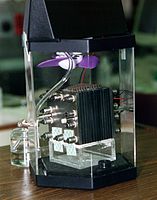
Photo from wikipedia
Currently, platinum is the most widely used catalyst for low temperature proton exchange membrane fuel cells (PEMFC). However, the kinetics at the cathode are slow, and the price of platinum… Click to show full abstract
Currently, platinum is the most widely used catalyst for low temperature proton exchange membrane fuel cells (PEMFC). However, the kinetics at the cathode are slow, and the price of platinum is high. To improve oxygen reduction reaction (ORR) kinetics at the cathode, platinum can be alloyed with rare earth elements, such as yttrium. We report that Pt3Y has the potential to be over 2 times more active for the ORR compared with Pt inside a real fuel cell. We present detailed photoemission analysis into the nature of the sputtered catalyst surface, using synchrotron radiation photoelectron spectroscopy (SRPES) to examine if surface adsorbates or impurities are present and can be removed. Pretreatment removes most of the yttrium oxide in the surface leaving behind a Pt overlayer which is only a few monolayers thick. Evidence of a substochiometric oxide peak in the Y 3d core level is presented, this oxide extends into the surface even after Ar+ sputter cleaning in-situ. This information will aid the development of new highly active nanocatalysts for employment in real fuel cell electrodes.
Journal Title: Fuel Cells
Year Published: 2020
Link to full text (if available)
Share on Social Media: Sign Up to like & get
recommendations!